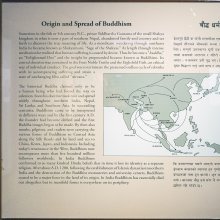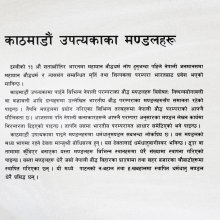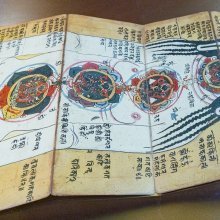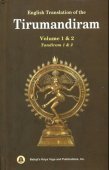Adhara, Ādhāra: 35 definitions
Introduction:
Adhara means something in Hinduism, Sanskrit, Buddhism, Pali, Marathi, Hindi. If you want to know the exact meaning, history, etymology or English translation of this term then check out the descriptions on this page. Add your comment or reference to a book if you want to contribute to this summary article.
Alternative spellings of this word include Adhar.
Images (photo gallery)
In Hinduism
Shilpashastra (iconography)
Source: Wisdom Library: Śilpa-śāstraĀdhāra (आधार) is a synonym for adhiṣṭhāna (‘platform’), according to the Kāśyapaśilpa 6.1-2. The word adhiṣṭhāna is Sanskrit technical term referring to the “base” or “platform” on which a structure is built.

Shilpashastra (शिल्पशास्त्र, śilpaśāstra) represents the ancient Indian science (shastra) of creative arts (shilpa) such as sculpture, iconography and painting. Closely related to Vastushastra (architecture), they often share the same literature.
Natyashastra (theatrics and dramaturgy)
Source: Wisdom Library: Nāṭya-śāstraAdhara (अधर) refers to the “lower lip”. It is one of the six minor limbs (upāṅga) used in dramatic performance, according to the Nāṭyaśāstra chapter 8. With these limbs are made the various gestures (āṅgika), which form a part of the histrionic representation (abhinaya).
Source: Shodhganga: The significance of the mūla-beras (natya)Adhara (अधर, “lower lip”) refers to one of the twelve “subsidiary limbs” (upāṅga), which represents a division of Āṅgikābhinaya (gesture language of the limbs) as used within the classical tradition of Indian dance and performance, also known as Bharatanatyam.—Āṅgika-abhinaya is the gesture language of the limbs. Dance is an art that expresses itself through the medium of body, and therefore, āṅgikābhinaya is essential for any dance and especially for any classical dance of India. Upāṅgas or the subsidiary limbs consist of the eyes, the eye-brows, pupils, cheeks, nose, jaws, lips [viz., lower lip: Adhara], teeth, tongue, chin, face, and the head.

Natyashastra (नाट्यशास्त्र, nāṭyaśāstra) refers to both the ancient Indian tradition (shastra) of performing arts, (natya—theatrics, drama, dance, music), as well as the name of a Sanskrit work dealing with these subjects. It also teaches the rules for composing Dramatic plays (nataka), construction and performance of Theater, and Poetic works (kavya).
Pancaratra (worship of Nārāyaṇa)
Source: Wisdom Library: PāñcarātraĀdhāra (आधार) refers to an aspect of nṛsiṃha (‘man-lion’), according to the Vihagendra-saṃhitā 4.17, which mentions seventy-four forms (inlcuding twenty forms of vyūha). He is also known as Ādhāranṛsiṃha or Ādhāranarasiṃha. Nṛsiṃha is a Tantric deity and refers to the furious (ugra) incarnation of Viṣṇu.
The 15th-century Vihagendra-saṃhīta is a canonical text of the Pāñcarātra corpus and, in twenty-four chapters, deals primarely with meditation on mantras and sacrificial oblations.

Pancaratra (पाञ्चरात्र, pāñcarātra) represents a tradition of Hinduism where Narayana is revered and worshipped. Closeley related to Vaishnavism, the Pancaratra literature includes various Agamas and tantras incorporating many Vaishnava philosophies.
Vyakarana (Sanskrit grammar)
Source: Wikisource: A dictionary of Sanskrit grammarĀdhāra (आधार).—Receptacle or abode of an action;cf.आध्रियन्ते अस्मिन् क्रियाः इत्याधारः (ādhriyante asmin kriyāḥ ityādhāraḥ) Kāś. on P.I.4.45 also M. Bh. on III.3.121; the Prakriyā Kaumudī mentions four kinds of ādhāras: cf. औपश्लेषिकः सामीपिको विषयो व्याप्त इत्याघारश्च-तुर्धा (aupaśleṣikaḥ sāmīpiko viṣayo vyāpta ityāghāraśca-turdhā) Prak. Kau. on II.3.36.

Vyakarana (व्याकरण, vyākaraṇa) refers to Sanskrit grammar and represents one of the six additional sciences (vedanga) to be studied along with the Vedas. Vyakarana concerns itself with the rules of Sanskrit grammar and linguistic analysis in order to establish the correct context of words and sentences.
Shaktism (Shakta philosophy)
Source: Google Books: Manthanabhairavatantram1) Ādhāra (आधार) refers to the “(twelve) supports”, according to the Ṣaṭsāhasrasaṃhitā, an expansion of the Kubjikāmatatantra: the earliest popular and most authoritative Tantra of the Kubjikā cult.—Accordingly, “A, U and Ma along with the Point (bindu) are in the heart, throat, and palate (respectively). The (Half) Moon, the Obstructress (nirodhikā), Sound (nāda), the End of Sound (nādānta), Power (śakti), the Pervasive One (vyāpinī), the Equal One (samanā) and the Transmental (unmanā) are (with the initial four) said to be the twelve supports (ādhāra). (Yogis) know that that is the End of the Twelve by making use (of the seed-syllable) A U Ma. [...]”.
2) Ādhāra (आधार) or Ādhāracakra refers to “foundation” and represents one of the “sixteen stations of the ascent of kuṇḍalinī” according to the Manthānabhairavatantra, a vast sprawling work that belongs to a corpus of Tantric texts concerned with the worship of the goddess Kubjikā.—Accordingly, “[...] (1) The Foundation (ādhāra) (at the base of the spine) is the first Wheel (brilliant and coloured) like red lac. There, in the middle, is the one called Haṃsa, (shining white) like a multitude of moons. [...]”.
3) Ādhāra (आधार) (or Mahānanda) is the name of the God (deva) associated with Oḍḍiyāna, one of the sacred seats (pīṭha), according to chapter 10 of the according to the Kularatnoddyota, one of the earliest Kubjikā Tantras.
4) Ādhāra (आधार) or Ādhāranātha is the name of the Siddha associated with the sacred seat of Oṃkāra (Oḍḍiyāna), according to the Manthānabhairavatantra.
Source: academia.edu: The Śāradātilakatantra on YogaĀdhāra (आधार, “support”) is mentioned by Lakṣmaṇadeśika in his 11th-century Śaradātilaka.—Ādhāra means literally “support”. The term seems to include certain places in the suṣumṇā (including the energy centres called wheels [cakra] or lotuses); cf. verse 64 and also the sixteen places listed in verses 24–5. Rāghavabhaṭṭa, p. 902, 13 notes that different authorities specify the number of ādhāras as twelve, sixteen or many. His list, quoting an unidentified source, includes the six energy centres (Rāghavabhaṭṭa, pp. 902, 14–903, 16; cf. also Kālīcaraṇa, p. 37, 12–16 on Ṣaṭcakranirūpaṇa, verse 33).
Source: Brill: Śaivism and the Tantric Traditions (shaktism)Ādhāra (आधार) refers to a “bases”, according to the King Vatsarāja’s Pūjāstuti called the Kāmasiddhistuti (also Vāmakeśvarīstuti), guiding one through the worship of the Goddess Nityā.—Accordingly, “[...] O goddess, I praise you with mind and speech. [...] Dwelling originally in the abode of Śiva, you multiply yourself sixfold and prepare the path of existence where you nurture wonderful and manifold creation with your own six forms. You shed moonlight on the path of Suṣumṇā that is charming due to the beautiful appearance of the six lotuses serving as [your] bases (ādhāra-vāriruha-ṣaṭka)”.

Shakta (शाक्त, śākta) or Shaktism (śāktism) represents a tradition of Hinduism where the Goddess (Devi) is revered and worshipped. Shakta literature includes a range of scriptures, including various Agamas and Tantras, although its roots may be traced back to the Vedas.
Shaivism (Shaiva philosophy)
Source: academia.edu: The Śaiva Yogas and Their Relation to Other Systems of YogaĀdhāra (आधार, “support”).—The sixteen types of “locus,” or “support” (ādhāra) are taught in two different setups: according to the tantraprakriyā and according to the kulaprakriyā. The Netratantra calls them loci because they “support” or “localise” the self.
The tantraprakriyā system is as follows:
- big toes (aṅguṣṭha),
- ankles (gulpha),
- knee (jānu),
- genitals (meḍhra),
- anus (pāyu),
- the bulb (kanda),
- the channel (nāḍi),
- stomach (jaṭhara),
- heart (hṛt),
- kūrmanāḍī,
- throat (kaṇṭha),
- palate (tālu),
- between the eyebrows (bhrūmadhya),
- forehead (lalāṭa),
- cranial apperture (brahmarandhra),
- limit of twelve (dvādaśānta).
These ādhāras are commonly identified as places where breath may be retained. While sixteen is a common number for the ādhāras there are also some variations.
Source: Brill: Śaivism and the Tantric TraditionsAdhara (अधर) refers to the “lips”, according to the 13th-century Matsyendrasaṃhitā: a Kubjikā-Tripurā oriented Tantric Yoga text of the Ṣaḍanvayaśāmbhava tradition from South India.—Accordingly, “[Visualisation of Parameśvara]:—[...] He is adorned with nice anklets, armlets, rings and bracelets, and he shines with small toe rings, channahīras, etc., and diadems and a crown. His face is gracious, beautiful, his lips are smeared (āpūrita-adhara) with betel leaves. His mind is filled with the joy of wine, and his body is supreme bliss [itself]. [...]”.

Shaiva (शैव, śaiva) or Shaivism (śaivism) represents a tradition of Hinduism worshiping Shiva as the supreme being. Closely related to Shaktism, Shaiva literature includes a range of scriptures, including Tantras, while the root of this tradition may be traced back to the ancient Vedas.
Ayurveda (science of life)
Source: gurumukhi.ru: Ayurveda glossary of terms1) Ādhāra (आधार):—Base - Some particular organs, or group of organs which are container of some biological matter
2) Adhara (अधर):—[adharaḥ] (1) lower lip. (2) Lower or inferior in position. Soft external structure that forms the boundary of the mouth.

Āyurveda (आयुर्वेद, ayurveda) is a branch of Indian science dealing with medicine, herbalism, taxology, anatomy, surgery, alchemy and related topics. Traditional practice of Āyurveda in ancient India dates back to at least the first millenium BC. Literature is commonly written in Sanskrit using various poetic metres.
Vastushastra (architecture)
Source: OpenEdition books: Architectural terms contained in Ajitāgama and RauravāgamaĀdhāra (आधार) refers to “base, level of— §§ 3.14; 4.6.”.—(For paragraphs cf. Les enseignements architecturaux de l'Ajitāgama et du Rauravāgama by Bruno Dagens)

Vastushastra (वास्तुशास्त्र, vāstuśāstra) refers to the ancient Indian science (shastra) of architecture (vastu), dealing with topics such architecture, sculpture, town-building, fort building and various other constructions. Vastu also deals with the philosophy of the architectural relation with the cosmic universe.
Purana and Itihasa (epic history)
Source: archive.org: Shiva Purana - English TranslationAdhara (अधर) refers to the “lower lip”, according to the Śivapurāṇa 2.3.18 (“Description of the perturbation caused by Kāma”).—Accordingly, as Śiva described Pārvatī: “Is this your face or the moon? Are these your eyes or lotus petals? These two eyebrows are the bows of Kāma of noble soul. Is this your lower lip or Bimba fruit [i.e., adhara—adharaḥ kiṃ ca biṃbaṃ]? Is this your nose or the beak of a parrot? Do I hear your voice or the cooing of the cuckoo? Is this your slender waist or the sacrificial altar? How can her gait be described? How can her comely appearance be described? How can the flowers be described? How can the clothes be described? [...]”.

The Purana (पुराण, purāṇas) refers to Sanskrit literature preserving ancient India’s vast cultural history, including historical legends, religious ceremonies, various arts and sciences. The eighteen mahapuranas total over 400,000 shlokas (metrical couplets) and date to at least several centuries BCE.
Vaishnavism (Vaishava dharma)
Source: Prabhupada Books: Sri Caitanya CaritamrtaAdhara (अधर) refers to the “lips (of Kṛṣṇa)”, according to the Śrī Caitanya Caritāmṛta 3.20 (“The Śikṣāṣṭaka Prayers”).—Accordingly, as Śrī Caitanya Mahāprabhu said said: “[...] Now let me repeat all the pastimes of the Antya-līlā, for if I do so I shall taste the pastimes again. [...] The Sixteenth Chapter tells how Śrī Caitanya Mahāprabhu showed His mercy to Kālidāsa and thus demonstrated the result of eating the remnants of the food of Vaiṣṇavas. It also describes how Śivānanda's son composed a verse and how the doorkeeper of the Siṃha-dvāra showed Kṛṣṇa to Śrī Caitanya Mahāprabhu. Also in that chapter, the glories of mahā-prasāda are explained, and a verse is tasted describing the effect of nectar from the lips of Kṛṣṇa (kṛṣṇa-adhara-amṛta [amṛtera]). [...]”.

Vaishnava (वैष्णव, vaiṣṇava) or vaishnavism (vaiṣṇavism) represents a tradition of Hinduism worshipping Vishnu as the supreme Lord. Similar to the Shaktism and Shaivism traditions, Vaishnavism also developed as an individual movement, famous for its exposition of the dashavatara (‘ten avatars of Vishnu’).
Yoga (school of philosophy)
Source: ORA: Amanaska (king of all yogas): A Critical Edition and Annotated Translation by Jason Birch1) Ādhāra (आधार) refers to the “receptacle (of divisions)”, according to the Devyāmata f. 30r2-3 (From the Paramatattvavicārapaṭala verse 57-60b).—Accordingly: while discussing the dichotomy of Śiva as mental and transmental: “[Śiva as] the receptacle of divisions (kalā-ādhāra) is mental whereas the supreme Śiva is beyond mind. The mental [aspect] is that which has mind alone, into which Śiva is fused and from which he does not ascend. That which has no mind and from which the mind does not return, is known as the no-mind [aspect of] the omniscient and all-pervasive Śiva”.
2) Ādhāra (आधार) refers to the “base (of the spine)”, according to the Amanaska Yoga.—Accordingly, as Īśvara says to Vāmadeva: “[...] [Now], I shall define the nature of that highest, mind-free absorption which arises for those devoted to constant practice. [...] By means of an absorption for half a Ghaṭikā (i.e., one hundred and eighty breaths), the highest power [called] Kuṇḍalinī is awake at the base (ādhāra-saṃsthitā) [of the spine] as a result of stopping the mind and breath. [...]”.

Yoga is originally considered a branch of Hindu philosophy (astika), but both ancient and modern Yoga combine the physical, mental and spiritual. Yoga teaches various physical techniques also known as āsanas (postures), used for various purposes (eg., meditation, contemplation, relaxation).
General definition (in Hinduism)
Source: Wisdom Library: HinduismĀdhāra (आधार) is a Sanskrit word referring to “site” or “foundation” of a house.
Languages of India and abroad
Pali-English dictionary
Source: BuddhaSasana: Concise Pali-English Dictionaryadhara : (m.) the lip. (adj.), lower. || ādhāra (m.), a container; receptacle; holder; basis; support; stand.
Source: Sutta: The Pali Text Society's Pali-English DictionaryAdhara, (adj.) (Vedic adhara, compar. of adho) the lower J.III, 26 (adharoṭṭha the l. lip). (Page 27)
— or —
Ādhāra, (ā + dhāra) — 1. a container, receptacle, basin, lit. holder A.III, 27; J.VI, 257. — 2. “holding up”, i. e. support, basis, prop. esp. a (round) stool or stand for the alms-bowl (patta) Vin.II, 113 (an° patto); M.III, 95; S.V, 21; J.V, 202. — fig. S.V, 20 (an° without a support, cittaṃ); Vism.8, 444. — 3. (tt. g.) name for the Loc. case (“resting on”) Sn.211. (Page 100)

Pali is the language of the Tipiṭaka, which is the sacred canon of Theravāda Buddhism and contains much of the Buddha’s speech. Closeley related to Sanskrit, both languages are used interchangeably between religions.
Marathi-English dictionary
Source: DDSA: The Molesworth Marathi and English Dictionaryadhara (अधर).—a (S) Lower, inferior.
--- OR ---
adhara (अधर).—a (For adhīra or a & dharaṇēṃ) Impatient.
--- OR ---
adhara (अधर).—ad adharaadhara ad (a & dhara Hold.) Lightly, loosely &c. Used freely as araḷa ad and in some senses as acānaka, acaḷavī, alāda &c. a0 ṭhēvaṇēṃ or lōmbaviṇēṃ To place or hang in midspace without support from beneath. a0 basaṇēṃ or lōmbaṇēṃ To sit, lie, hang &c. without support.
--- OR ---
adhara (अधर).—m (S) The lower lip: also the lips. 2 or adhara diśā f The nadir. a0 cāvaṇēṃ or cāvūna khāṇēṃ To bite the lip (in rage &c.) Ex. paramasantāpa vāṭalā tēvhāṃ || a0 cāvūna khātasē ||
--- OR ---
ādhāra (आधार).—m S Support, lit. fig., the power of sustaining, or the sustentation afforded. Ex. of comp. ādhāragata, ādhāracalana, ādhāracyuta, ādhāra- bhraṣṭa, ādhārasthāna, ādhārasthita, ādhārabhūta. 2 A support, that which supports, sustains, upholds, protects, lit. fig.; sanction, authority, warrant; patronage, countenance, favor. 3 In grammar. Comprehension or location, the sense of the seventh case. (In, on, at.)
Source: DDSA: The Aryabhusan school dictionary, Marathi-Englishadhara (अधर).—ad Lightly, in midspace, without any support from beneath.
--- OR ---
adhara (अधर).—m The lower lip.
--- OR ---
ādhāra (आधार).—m Support. Authority. Location.
Marathi is an Indo-European language having over 70 million native speakers people in (predominantly) Maharashtra India. Marathi, like many other Indo-Aryan languages, evolved from early forms of Prakrit, which itself is a subset of Sanskrit, one of the most ancient languages of the world.
Sanskrit dictionary
Source: DDSA: The practical Sanskrit-English dictionaryAdhara (अधर).—a. [na dhriyate; dhṛ-ac, na. ta.]
1) Lower (opp. uttara), (lit. not held up); tending downwards; under, nether, downwards; °वासः (vāsaḥ) under garment; असितमधरवासो विभ्रतः (asitamadharavāso vibhrataḥ) Kirātārjunīya 4.38; cf. अम्बर (ambara); सुवर्णसूत्राकलिताधराम्बराम् (suvarṇasūtrākalitādharāmbarām) Śiśupālavadha 1.6; °ओष्ठ (oṣṭha) lower or nether lip, see below. (In this sense adhara partakes of the character of a pronoun).
2) Low, mean, vile; °उत्तरम् (uttaram) See below; lower in quality, inferior.
3) Silenced, worsted, not able to speak; See हीन, हीनवादिन् (hīna, hīnavādin).
4) Previous, preceding as in अधरेद्युः (adharedyuḥ) q. v.
-raḥ The nether (or sometimes the upper) lip; in general °पत्रम् (patram). प्रवेपमानाधरपत्रशोभिना (pravepamānādharapatraśobhinā) Kumārasambhava 5.27 leaf-like lower lip; बिम्बाधरालक्तकः (bimbādharālaktakaḥ) M.3.5.; पक्कबिम्बाधरोष्ठी (pakkabimbādharoṣṭhī) Meghadūta 84; पिबसि रतिसर्वस्वमधरम् (pibasi ratisarvasvamadharam) Ś.1.21;1.23;3.23; cf. अधरं खलु बिम्बनामकं फलमाभ्यामिति भव्यमन्वयम् । लभतेऽधरबिम्ब इत्यदः पदमस्या रदनच्छदे वदत् (adharaṃ khalu bimbanāmakaṃ phalamābhyāmiti bhavyamanvayam | labhate'dharabimba ityadaḥ padamasyā radanacchade vadat) || N.2.24.
-rā The nadir; (adhodiś) or the southern direction.
-ram The lower part (of the body); पृष्ठवंशाधरे त्रिकम् (pṛṣṭhavaṃśādhare trikam) Ak.
2) Pudendum Muliebre (also m.).
3) Address. speech (opp. uttara); statement, sometimes used for reply also.
--- OR ---
Ādhāra (आधार).—[आ-धृ घञ् (ā-dhṛ ghañ); आध्रियन्तेऽस्मिन्क्रियाः इति (ādhriyante'sminkriyāḥ iti) Kāśi.)
1) Support, prop, stay; इत्याधारानुरोधात्त्रिपुरविजयिनः पातु वो दुःखनृत्तम् (ityādhārānurodhāttripuravijayinaḥ pātu vo duḥkhanṛttam) (Some annotators explain ādhāra as local conditions); Mu.1.2.
2) (Hence) Power of sustaining, aid, patronage, assistance; त्वमेव चातकाधारः (tvameva cātakādhāraḥ) Bhartṛhari 2.5.
3) A receptacle, reservoir; तिष्ठन्त्याप इवाधारे (tiṣṭhantyāpa ivādhāre) Pañcatantra (Bombay) 1.67; चराचराणां भूतानां कुक्षिराधारतां गतः (carācarāṇāṃ bhūtānāṃ kukṣirādhāratāṃ gataḥ) Kumārasambhava 6.67; अपामिवाधारमनु- त्तरङ्गम् (apāmivādhāramanu- ttaraṅgam) Kumārasambhava 3.48; तोयाधारपथाश्च वल्कलशिखानिष्यन्दरेखाङ्किताः (toyādhārapathāśca valkalaśikhāniṣyandarekhāṅkitāḥ) Ś.1.14; आधारः क्षमाम्भसाम् (ādhāraḥ kṣamāmbhasām) K.44; Y.3.144,165.
4) That which holds or contains, a vessel, recipient.
5) A part, character (in dramas); भेदैः सूक्ष्मैरभिव्यक्तैः प्रत्याधारं विभज्यते (bhedaiḥ sūkṣmairabhivyaktaiḥ pratyādhāraṃ vibhajyate) Mv.1.3.
6) A basin round the foot of a tree; आधारबन्धप्रमुखैः प्रयत्नैः (ādhārabandhapramukhaiḥ prayatnaiḥ) R.5.6.
7) A dike, dam, embankment.
8) A canal.
9) The sense of the locative case, location, comprehension; आधारोऽधिकरणम् (ādhāro'dhikaraṇam); (ādhāra is of 3 kinds. -aupaśleṣika, vaiṣayika, and abhivyāpaka see Sk. on P.I.4.45).
1) Relation.
11) A ray. cf. आधार आलवालेऽम्बुबन्धे च किरणेऽपि च (ādhāra ālavāle'mbubandhe ca kiraṇe'pi ca) Nm.
Derivable forms: ādhāraḥ (आधारः).
Source: Cologne Digital Sanskrit Dictionaries: Edgerton Buddhist Hybrid Sanskrit DictionaryĀdhāra (आधार).—(-ādhāra), see śrutādhāra.
Source: Cologne Digital Sanskrit Dictionaries: Shabda-Sagara Sanskrit-English DictionaryAdhara (अधर).—mfn.
(-raḥ-rā-raṃ) 1. Low, inferior, below. 2. Low, vile. 3. Silenced, refuted, overcome in abuse or controversy. f.
(-rā) The lower region. m.
(-raḥ) The lower lip. (dual. rau) The lips. mn.
(-raḥ or raṃ) Pudendum muliebre. E. a neg. dhṛ to have or hold, and ac aff.
--- OR ---
Ādhāra (आधार).—m.
(-raḥ) 1. Support, prop, stay. 2. Receptacle. 3. Comprehen- sion, location, the sense of the ablative in or on. 4. A dike, a canal. 5. A basin round the foot of a tree. E. āṅ and dhṛ to hold or contain, ghañ aff.
Source: Cologne Digital Sanskrit Dictionaries: Benfey Sanskrit-English DictionaryAdhara (अधर).— (an old comparative, akin to adhas). I. adj., f. rā. Lower, inferior. Ii. m. 1. The lower lip [Śākuntala, (ed. Böhtlingk.)] 102, 10. 2. The lip in general, [Śiśupālavadha] 9, 46.
--- OR ---
Ādhāra (आधार).—i. e. ā-dhṛ + a, m. 1. A prop, support, [Rāmāyaṇa] 5, 3, 77; [Vedāntasāra, (in my Chrestomathy.)] in
Adhara (अधर).—[adjective] lower; adharaṃ kṛ subdue, adharaḥ pad be subdued. [masculine] the lower lip, coll. the lips.
--- OR ---
Ādhāra (आधार).—[masculine] support, basis (l.&[feminine]); receptacle, canal; ([grammar]) province, sphere (of an action).
Source: Cologne Digital Sanskrit Dictionaries: Aufrecht Catalogus CatalogorumĀdhāra (आधार) as mentioned in Aufrecht’s Catalogus Catalogorum:—supposed author of the Ādhārakārikāḥ. Oxf. 238^b. 353^b.
Source: Cologne Digital Sanskrit Dictionaries: Monier-Williams Sanskrit-English Dictionary1) Adhara (अधर):—mfn. (connected with adhas), lower, inferior, tending downwards
2) low, vile
3) worsted, silenced
4) m. the lower lip, the lip
5) Adharā (अधरा):—[from adhara] f. the lower region, nadir
6) Adhara (अधर):—n. the lower part; a reply; pudendum muliebre, [cf. Lexicographers, esp. such as amarasiṃha, halāyudha, hemacandra, etc.]
7) [Latin] inferus.
8) Ādhara (आधर):—[=ā-dhara] a See under ā-√dhṛ.
9) Ādhāra (आधार):—[=ā-dhāra] a etc. See under ā-√dhṛ.
10) Ādhara (आधर):—[=ā-dhara] [from ā-dhṛ] b mfn. ifc. supportable, tenable (cf. dur).
11) Ādhāra (आधार):—[=ā-dhāra] [from ā-dhṛ] b m. support, prop, stay, substratum
12) [v.s. ...] the power of sustaining, or the support given, aid, patronage, [Atharva-veda xii, 3, 48; Mahābhārata; Suśruta; Vedāntasāra] etc.
13) [v.s. ...] that which contains (a fluid etc.), a vessel, receptacle, [Yājñavalkya; Suśruta; Pañcatantra] etc.
14) [v.s. ...] a dike, dam, [Raghuvaṃśa]
15) [v.s. ...] a basin round the foot of a tree, [cf. Lexicographers, esp. such as amarasiṃha, halāyudha, hemacandra, etc.]
16) [v.s. ...] a reservoir, pond, [cf. Lexicographers, esp. such as amarasiṃha, halāyudha, hemacandra, etc.]
17) [v.s. ...] (in [philosophy] and [grammar]) comprehension, location, the sense of the locative case
18) [v.s. ...] ifc. belonging or relating to
19) [v.s. ...] the subject in a sentence (of which qualities etc. are affirmed)
20) [v.s. ...] Name of a lake
21) [v.s. ...] of an author.
Source: Cologne Digital Sanskrit Dictionaries: Goldstücker Sanskrit-English DictionaryAdhara (अधर):—I. m. f. n.
(-raḥ-rā-ram) 1) Lower, inferior, in place. (In this sense the word is declined like the sarvanāman yat &c. (q. v.), but in the abl. and loe. sing. of the mase. and neuter and in the nom. plur. of the mase. it forms optionally adharasmāt or adharāt, adharasmin or adhare, adhare or adharāḥ; it may form [tatpurusha compound] compositions with nouns having the sense of the singular and considered then as depending upon adhara, which is the former part of the compound, in the genitive; for instance adharakāyaḥ is explained, adharaṃ kāyasya.) Adverbially used are adharāt, adharasmāt, adhareṇa; qq. vv.
2) Low, vile.
3) Speechless, refuted, overcome in abuse or controversy.
4) Prior, preceding in time. See adharedyus. Ii. m.
(-raḥ) The lower lip, the lip. Iii. f.
(-rā) 1) The lower region.
2) The nadir (?). Iv. m. n.
(-raḥ-ram) Pudendum muliebre. E. Probably from adh (see E. of adhama), aff. ara; the derivation given by the native authorities, from a neg. and dhara is not correct.
Source: Cologne Digital Sanskrit Dictionaries: Yates Sanskrit-English Dictionary1) Adhara (अधर):—[(ra-rā-raṃ) a.] Low. m. The lower lip. f. The lower region.
2) Ādhāra (आधार):—(raḥ) 1. m. Prop; receptacle; comprehension; a dike, a container of water, &c.
Source: DDSA: Paia-sadda-mahannavo; a comprehensive Prakrit Hindi dictionary (S)Adhara (अधर) in the Sanskrit language is related to the Prakrit word: Ahara.
[Sanskrit to German]
Sanskrit, also spelled संस्कृतम् (saṃskṛtam), is an ancient language of India commonly seen as the grandmother of the Indo-European language family (even English!). Closely allied with Prakrit and Pali, Sanskrit is more exhaustive in both grammar and terms and has the most extensive collection of literature in the world, greatly surpassing its sister-languages Greek and Latin.
Hindi dictionary
Source: DDSA: A practical Hindi-English dictionary1) Adhara (अधर) [Also spelled adhar]:—(nm) underlip; lip; midair, empty space, space between earth and sky; —[pāna] sucking/kissing of the lips; —[meṃ] without support underneath; propless; —[meṃ jhūlanā/laṭakanā] to hang in mid-air, to be without a prop.
2) Ādhāra (आधार) [Also spelled adhar]:—(nm) base; basis; foundation; data; receptacle; -[ādheya] the relationship of the container and the contained; ~[bhūta] fundamental; ~[rekhā] base: -[vākya] premise; ~[śilā] foundation stone; -[sāmagrī] data.
...
Kannada-English dictionary
Source: Alar: Kannada-English corpusAdhara (ಅಧರ):—
1) [adjective] lying or thought of as lying, below ; nether.
2) [adjective] low or lower in order, status, rank, etc.; inferior.
3) [adjective] lower in quality or value than; base; contemptible.
--- OR ---
Adhara (ಅಧರ):—
1) [noun] lower one of the two fleshy folds forming the edges of the mouth and important in speech; the lower lip.
2) [noun] (in gen.) any of the two lips; the lip.
3) [noun] that point of the celestial sphere directly opposite to the zenith and directly below the observer; the nadir.
4) [noun] the lowest portion of any thing.
5) [noun] one who has been silenced in argument; he who cannot argue any more.
6) [noun] equality; likeness.
7) [noun] the colour of human blood; red colour.
--- OR ---
Ādhara (ಆಧರ):—[noun] one who tells about his own failure or defeat.
--- OR ---
Ādhāra (ಆಧಾರ):—
1) [noun] a place or power of protection; a resort; a patronage.
2) [noun] a support, a person or thing that supports; esp. a) a prop, base, brace, etc.; b) a means of subsistence; c) an elastic, girdlelike device to support or bind a part of the body.
3) [noun] an authoritative reference in support of one’s statement or argument; a base; a basis.
4) [noun] the foundation or lower part of a wall or structure; basement.
5) [noun] a current or flow of water or other liquid, esp. one running along the surface of the earth; a stream.
6) [noun] that which holds water (esp. in great quantity); a reservoir of water.
7) [noun] (gram.) the sense of locative sense.
8) [noun] (myst.) a mystical point in the human body that gives the power of sustaining.
9) [noun] a property or an estate mortgaged for repayment of a loan; a pledge; a security.
Kannada is a Dravidian language (as opposed to the Indo-European language family) mainly spoken in the southwestern region of India.
See also (Relevant definitions)
Starts with (+100): Adharabheda, Adharabhuta, Adharacakra, Adharachakra, Adharachina, Adharachya, Adharacina, Adharacya, Adharadala, Adharadayaka, Adharadhar, Adharadhara, Adharadheyabhava, Adharadheyabhavatattvapariksha, Adharadisha, Adharaganchiambu, Adharagey, Adharagraha, Adharaguda, Adharahanu.
Ends with (+518): Abhayadhara, Acchinnadhara, Achchhinnadhara, Adharadhara, Adigadadhara, Agadhara, Agradhara, Ajitadhara, Ajnabaladhara, Ajnadhara, Akarnadhara, Akhiladhara, Akshadhara, Akshamaladhara, Aksharadhara, Akshasutradhara, Ambaradhara, Amdakadhara, Amritadhara, Amshadhara.
Full-text (+230): Raktadhara, Adharina, Adharoshtha, Adharatas, Adharat, Adharavalopa, Adharakaya, Duradhara, Pallavadhara, Brahmarandhra, Janu, Hrid, Lalata, Gulpha, Angushtha, Adharibhuta, Bhrumadhya, Adharata, Adharacakra, Adharottara.
Relevant text
Search found 65 books and stories containing Adhara, Ādhāra, Adharā, Ādhara, A-dhara, Ā-dhara, Ā-dhāra; (plurals include: Adharas, Ādhāras, Adharās, Ādharas, dharas, dhāras). You can also click to the full overview containing English textual excerpts. Below are direct links for the most relevant articles:
Garga Samhita (English) (by Danavir Goswami)
Verse 3.8.5 < [Chapter 8 - The Opulences of Śrī Girirāja]
Verse 2.13.28 < [Chapter 13 - The Story of Śeṣa]
Verse 5.8.18 < [Chapter 8 - The Killing of Kaṃsa]
Rig Veda (translation and commentary) (by H. H. Wilson)
Sahitya-kaumudi by Baladeva Vidyabhushana (by Gaurapada Dāsa)
Text 10.7 < [Chapter 10 - Ornaments of Meaning]
Text 4.90 < [Chapter 4 - First-rate Poetry]
Text 10.232 [Viśeṣa] < [Chapter 10 - Ornaments of Meaning]
Shat-cakra-nirupana (the six bodily centres) (by Arthur Avalon)
Vakyapadiya of Bhartrihari (by K. A. Subramania Iyer)
Verse 3.3.86 < [Book 3 - Pada-kāṇḍa (3): Sambandha-samuddeśa (On Relation)]
Verse 3.3.13 < [Book 3 - Pada-kāṇḍa (3): Sambandha-samuddeśa (On Relation)]
Verse 3.7.68 < [Book 3 - Pada-kāṇḍa (7): Sādhana-samuddeśa (On the Means)]
Bhakti-rasamrta-sindhu (by Śrīla Rūpa Gosvāmī)
Verse 2.5.69 < [Part 5 - Permanent Ecstatic Mood (sthāyī-bhāva)]
Verse 4.8.26 < [Part 8 - Compatible & Incompatible Mellows (maitrī-vaira-sthiti)]
Verse 3.4.40 < [Part 4 - Parenthood (vātsalya-rasa)]
Related products





